[Crypto Assets Diversification] - Crypto Academy / S4W4 - Homework Post for professor @fredquantum

Question 1
Explain Crypto Assets Diversification
Crypto Asset Diversification
A crypto-asset diversification is an asset management strategy used in an attempt to control portfolio and risk exposure in a traded market. Asset diversification is achieved by splitting percentages of the invested capital into different asset types. This reduces the risk impact on the invested capital, considering the unpredictable nature of the market, where fundamental and technical constraints contribute.
Creating a diversified asset portfolio utilizes some key factors within its construct, some of which include analysis (fundamental and technical), risk percentage, investment projections, etc. The portfolio management strategy is combined with predefined risk containment levels in form of stoploss, to better handle bad trading decisions, which drastically reduce the negative impact on the invested capital. Asset diversification strategy is used across all financial markets, from forex, crypto, indices, futures contract, etc.
There are different types of assets, and each with different analysis projections, ideally, some assets can only sustain short term biases, while some can sustain long term biases, this creates an aggregated investment opportunity, which requires investing in short-term and long-term, creating problems for a non-diversified portfolio investor.
But when a diversified portfolio is used, investors can maintain a balanced portfolio by investing in percentages of the capital and capitalizing on the available opportunities. This prevents emotional constraints like Fear Of Missing Out (FOMO), Fear, Uncertainty, Doubt (FUD), etc.

Question 2
What are the Benefits/effects of Diversifying one's assets?
Benefits of Portfolio Diversification
Some advantages of diversifying a portfolio include the following:
1- Reduced Risk and Exposure
A diversified crypto portfolio reduces the overall risk and exposure of the capital invested. This is because asset price movements are different. For instance, a fundamental tick can influence the price movement of a particular asset positively or negatively. Adopting the diversification strategy will reduce the negative impact on the portfolio.
2- Different investment opportunities
Diversifying a portfolio increases the chances of investing in different assets, this is because a percentage of the investment is allocated to each asset listed in the portfolio. For instance, investing 10% per asset can allow investments in 10 different assets.
3- Increased profit margin
Adopting a diversified portfolio increases the profit margin of the overall investment, as each investment returns is compounded. This boosts the overall profit percentage of the portfolio.
Effects of Portfolio Diversification
Some of the disadvantages of Portfolio diversification are as follows:
1- Time Management and Analysis
Having multiple crypto assets in a portfolio requires more time and experience to analyze and monitor the portfolio since the movement of price is concurrent. Assets react differently in different market situations, this requires regularized monitoring routine to maintain profitability and an overall balanced portfolio.
2- Increased transaction cost
Operating a diversified portfolio requires buying and selling different assets at different times, this greatly increases transaction costs and network fees. In an instance of an Ethereum blockchain-based token, the network fee will be relatively higher compared to others. Although this can be checkmated with properly choosing the assets.
3- Crypto Dominance correlation
The crypto ecosystem is dominated mainly by Bitcoin and other top-rated cryptocurrencies. This impacts the overall movement of price. For instance, a decline in the price of BTC affects other crypto assets (alt-coins), causing a correlated sentiment across the crypto ecosystem. This implies that diversifying a crypto portfolio won't do much because the entire crypto market will likely be doing the same thing with slight differences.

Question 3
Construct Crypto Assets Diversification according to the 1 - 4 Rule - Choose 4 crypto asset (State the reasons for choosing them), discuss each of the assets, and perform a detailed fundamental/technical analysis on them. Invest a part of at least 15 USD into each of the assets based on the diversification constructed earlier, proper stop loss and take profit levels must be put into place. A real trade on a centralized exchange is expected here.
The 1 - 4 Rule
As explained in the lesson, the 1-4 rule is a constituent method of diversifying a portfolio. This is achieved by dividing the capital (reservoir) into four parts (pools) and investing 25% per asset. For this illustration, I chose Bitcoin, Ethereum, Cardano, and Ripple.
Crypto Analysis
Asset 1- Bitcoin
Bitcoin, the first cryptocurrency, developed by and introduced by Satoshi Nakamoto in Jan 2009, is a decentralized network where nodes exchange digital currency in a peer-to-peer format. This idea gave birth to the concept of Blockchain and its technology, where transactions are carried out in a trustless manner promoting transparency and owner access control.
The Bitcoin network uses a proof-of-work consensus algorithm, which implies that nodes (miners) mine transaction blocks through solving complex mathematical computations, using high-powered computers, in exchange they earn new bitcoins.
I chose bitcoin because of its market dominance, it dominates about 42.14% of the crypto ecosystem, and it's the only crypto to have stayed up to a decade.
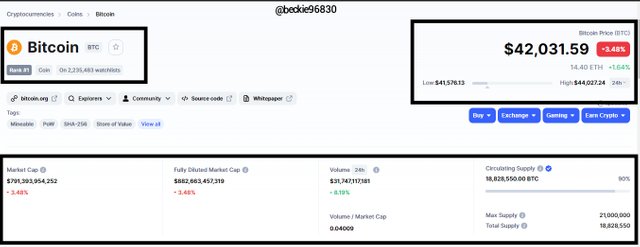
The current price of BTC is $42,031.59, with a market capitalization of $791,393,954,252 and a diluted market cap of $882,663,457,319. The traded volume in the last 24 hours is $31,747,117,181. Bitcoin has a circulating supply of 18,828,550.00 BTC with a max supply of 21,000,000 BTC.
From a technical standpoint, Bitcoin price is fluctuating around a strong key level of support and previous resistance around $40,000. A break below the support can see Bitcoin price drive to $31,000. But if the support is respected, Bitcoin's price can easily reach $47,000, this investment will yield 11.9% profit.
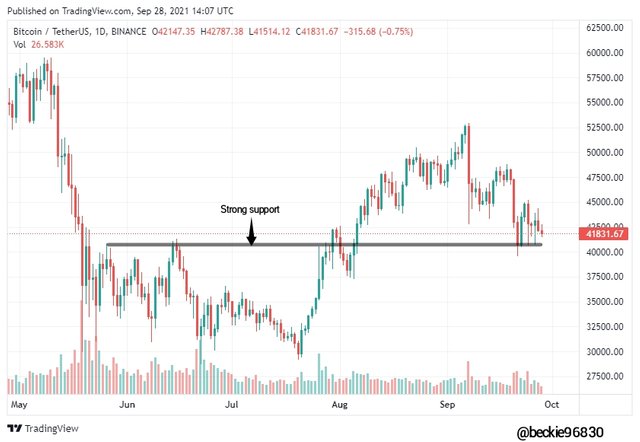
Asset 2- Ethereum
Ethereum is an open-source decentralized blockchain developed by Vitalik Buterin and other developers. It was officially launched in 2015. Ethereum is the second most used crypto, with a core focus of creating a decentralized platform for applications (DApps) to run on, also the creation of automated instruction executer in form of smart contracts.
Ethereum previously used the proof-of-work (PoW) consensus algorithm, but with the recent "London" hard fork that took place on the 5 th of August 2021, the network migrated to a proof-of-stake (PoS) network. Ethereum had a successful crowd sale in 2014 to kick start its development, as about $18.3 Million was raised. The Blockchain is also notoriously known for the high cost of transactions.
Ethereum has a market dominance of about 18.31%, the current price of its native token Ether (ETH) is $2,866.43. Ethereum has a market capitalization of $337,407,562,666 and a diluted market cap of $337,407,562,666 and the traded volume in the last 24 hours is $17,601,664,756.
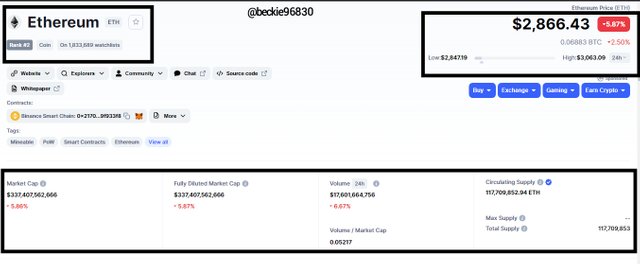
The Ether coin has a circulating supply of 117,709,852.94 ETH and an unlimited Max supply.
From a technical standpoint, Ethereum price is fluctuating around a strong key level of support and previous resistance around $2,800. A break below the support can see Bitcoin price drive to $1,800. But if the support is respected, Bitcoin price can easily reach $4,000, this investment will yield 42.86% profit.
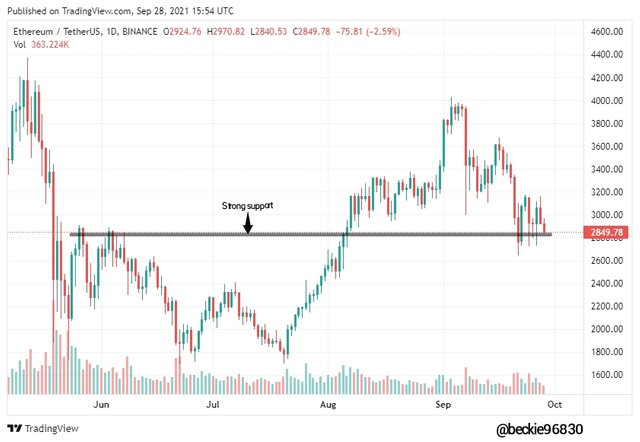
Asset 3- Cardano
Cardano is a decentralized blockchain that adopts the proof-of-stake consensus within its network. Cardano was developed to tackle the problems facing the second generation of blockchains like ethereum 2.0, the problems include scalability (in range of millions of users), transaction cost and gas fees, sustainability, etc. Cardano empowers users of the platform in an attempt to encourage innovators, visionaries, and changemakers to impact the world positively.
Cardano's founder is Charles Hoskinson. He's a grounded figure in the cryptocurrency ecosystem, best known as the co-founder of Ethereum. He created Cardano with a collection of experts in various fields, and together they created the first 3rd generation blockchain that has a future proof use case considering scalability, reduced cost, and interoperability.
Cardano has a market dominance of about 3.64%, the current price of its native token ADA is $2.08. Cardano has a market capitalization of $66,643,376,744 and a diluted market cap of $93,641,786,942, and the traded volume in the last 24 hours is $2,765,837,720.
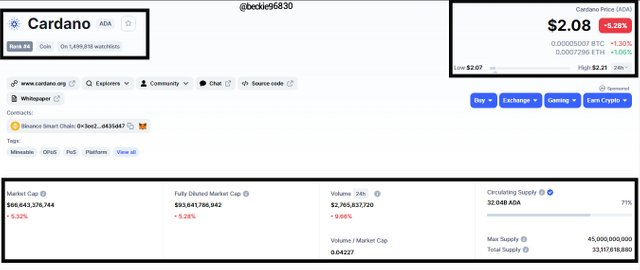
The ADA coin has a circulating supply of 32,040,000,000 ADA and a Max supply of 45,000,000,000 ADA.
From a technical standpoint, Cardano's price is fluctuating around a strong key level of support and previous resistance around $2.080. A break below the support can see Bitcoin price drive to $1.100. But if the support is respected, Bitcoin price can easily reach $2.750, this investment will yield 32.21% profit.
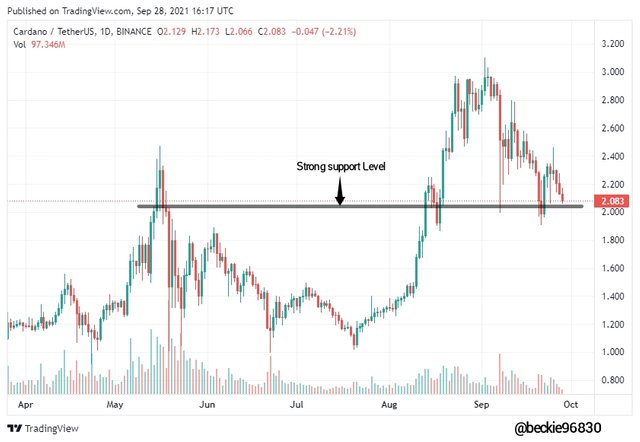
Asset 4- XRP
The XRP is a digital currency used on the RippleNet payment platform, which is a payment settlement solution created to facilitate fast fund transactions globally. The concept was introduced by Ryan Fugger in 2004 but was developed by Jed McCaleb and Chris Larson in 2012. XRP offered a lighter platform that is capable of processing international transactions fast, cheaper, and sustaining a more scalable network.
Within the network, XRP serves as a mediating currency, such that, foreign instruments (crypto, foreign exchange, etc.) are swapped to their XRP equivalent, and then routed to the destination, where it is swapped back to the desired currency, before being transferred to the intended receiver.
The Ripple network system is designed to allow appointed nodes to serve as network validators, whose core function is to validate transactions every 3-5 seconds. This distributed ledger system uses the proof-of-work (PoW) consensus algorithm to manage the network activities and transactions.
XRP has a market dominance of about 2.33%, the current price of its native token XRP is $0.9133. XRP has a market capitalization of $42,669,016,222 and a diluted market cap of $91,333,842,420, and the traded volume in the last 24 hours is $2,747,088,443.
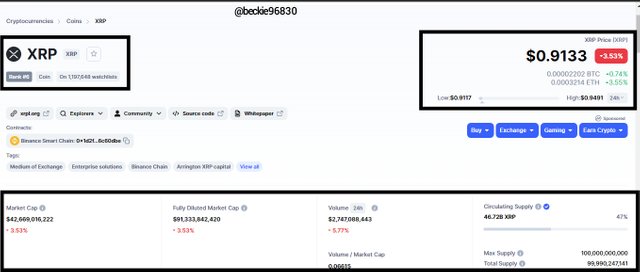
The XRP coin has a circulating supply of 46,720,000,000 XRP and a Max supply of 100,000,000,000 XRP.
From a technical standpoint, XRP price is fluctuating around a strong key level of support and previous resistance around $0.9000. A break below the support can see Bitcoin price drive to $0.5500. But if the support is respected, Bitcoin price can easily reach $1.3550, this investment will yield 50.55% profit.
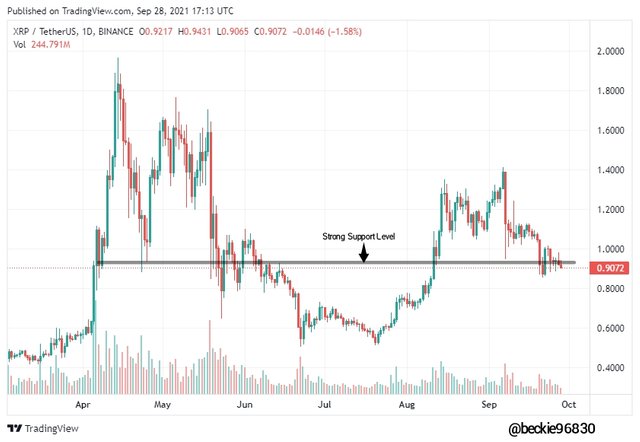
Investing using The 1 - 4 Rule
First, visit any crypto exchange login. For this illustration, I will use the Binance exchange.
First, access the exchange through its official website and proceed with the login. Then access the wallet section and show proof of reservoir
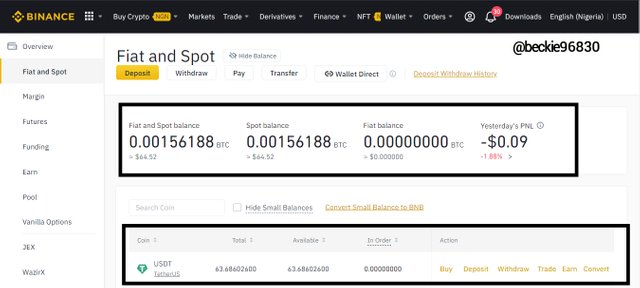
As seen above, my total exchange balance is $63, but my investing reservoir balance is $60, and I intend to invest 25% per asset, which is equivalent to $15 per asset.
Click on trade to access the listed assets.
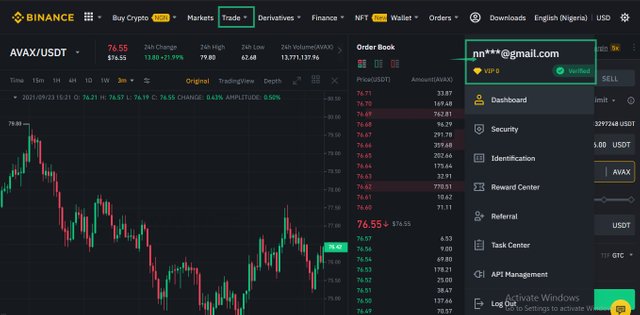
BTCUSDT
Next, search for BTCUSDT and choose the pair
Next, choose the appropriate transaction details, transaction type is Buy, choose trade execution type as market, Enter the amount of BTC to be purchased in USDT from the available balance, the click on Buy BTC.
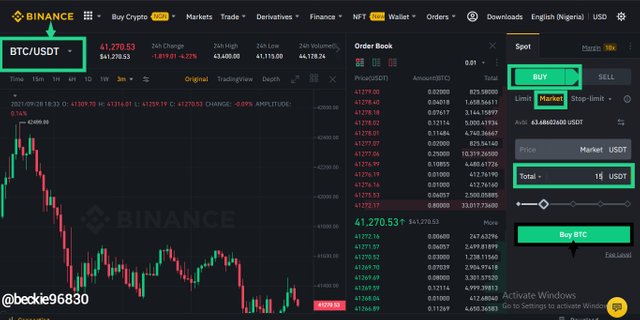
ETHUSDT
Next, search for ETHUSDT and choose the pair
Next, choose the appropriate transaction details, transaction type is Buy, choose trade execution type as market, Enter the amount of ETH to be purchased in USDT from the available balance, the click on Buy ETH.
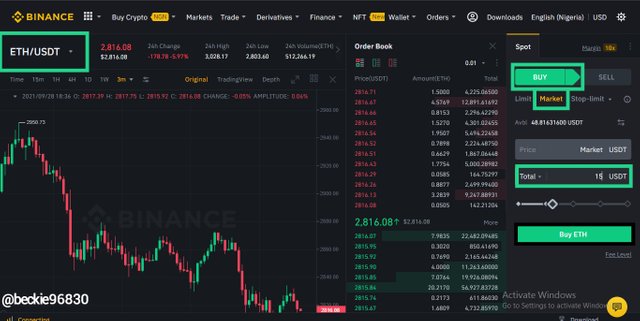
ADAUSDT
Next, search for ADAUSDT and choose the pair
Next, choose the appropriate transaction details, transaction type is Buy, choose trade execution type as market, Enter the amount of ADA to be purchased in USDT from the available balance, the click on Buy ADA.
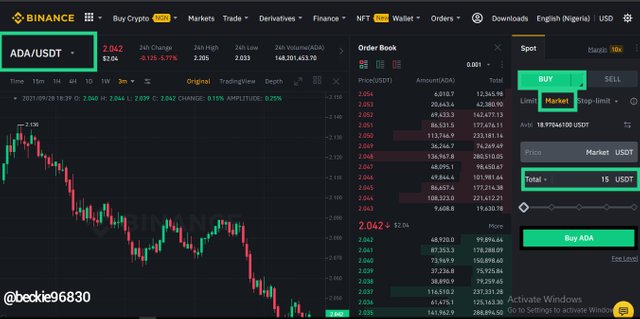
XRPUSDT
Next, search for XRPUSDT and choose the pair
Next, choose the appropriate transaction details, transaction type is Buy, choose trade execution type as market, Enter the amount of XRP to be purchased in USDT from the available balance, the click on Buy XRP.
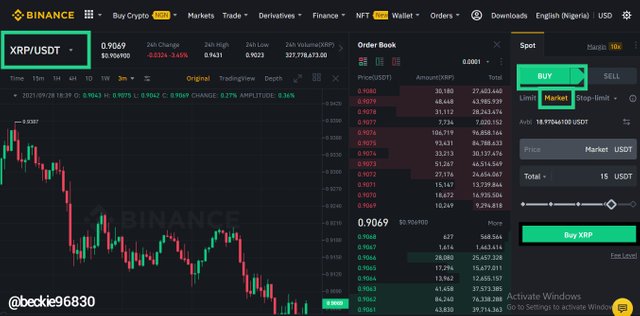
The investment transaction history is recorded on the exchange account.
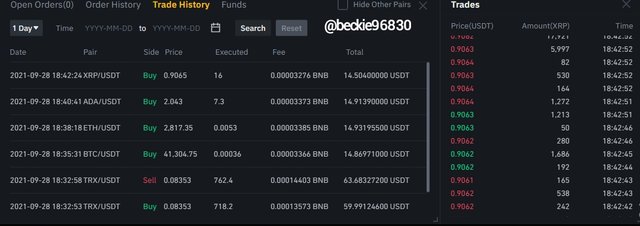

Question 4
Explain Arbitrage Trading in Cryptocurrency and its benefits.
Arbitrage Trading
Arbitrage trading is an investment strategy that capitalize on the price difference of assets to make short-term trade investments. The sole purpose of arbitrage trading is providing a low risk-based trading through buying assets at lower prices and selling at higher prices.
Trading experience is required to capitalize on arbitrage trading, as it entails spotting slight price differences between exchanges for the same asset, or a profitable loop between prices of different listed assets, and capitalize on that opportunity window.
Another key factor of arbitrage trading is that it requires a good starting capital, since the investment is short-term based and sometimes quick, trading the arbitrage strategy with small capital will result in an unhealthy risk of capital.
Benefits of Arbitrage Trading
Some benefits of arbitrage trading include the following:
1- Low Risk
Arbitrage trading involves trading with low risk since trade orders are quickly executed simultaneously and closed, the overall exposure to risk is reduced.
2- Multiple trade Opportunities
Arbitrage trade opportunities occur frequently, as exchange prices always differ by small margins, this creates multiple trade opportunities to be capitalized on by investors.
3- Automated System
The concept of arbitrage trading is relatively easy to understand and can be programmed, such that spotting the arbitrage opportunities are handled by software linked to various exchange platforms. This makes it easy to trade.

Question 5
Discuss with illustration how to take advantage of Exchange Arbitrage.
Exchange Arbitrage
Exchange arbitrage occurs as a result of different exchange prices for the same asset. Different exchanges offer different prices for the same asset, this phenomenon can result from the spread, liquidity, the volume of the assets, and the exchange flow activities.
For instance, Exchange A listed BTC price is $41,280 while Exchange B listed BTC price is $41,300, an exchange arbitrage trade can be taken by buying BTC from Exchange A and selling on Exchange B, aiming to capitalize on the $20 price difference.
Consider the real illustration below:
For this illustration, I compared two exchanges on coimmarketcap, the two exchanges are Binance and Coinbase, to compare the price of BTCUSDT in both exchanges.
Binance Exchange
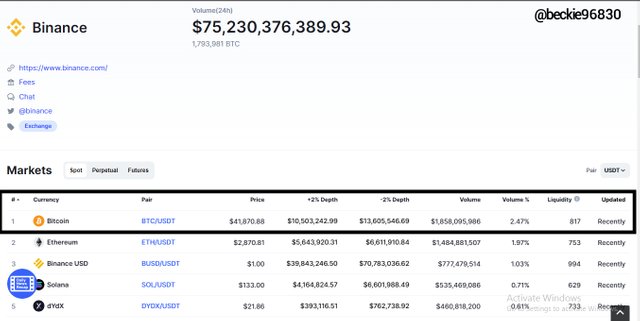
From the above image, Binance listed price for BTCUSDT is $41,870.88, with the liquidity of 817.
Coinbase Exchange
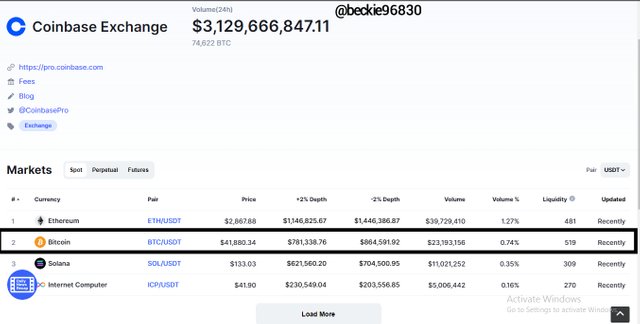
From the above image, Coinbase listed price for BTCUSDT is $41,880.34, with the liquidity of 519.
Comparing the two exchanges above, an arbitrage value of $9.46 is the difference between the price listed on the two exchanges for the same asset BTCUSDT.
Ideally, an arbitrage trader can buy BTCUSDT from Binance exchange because of lower prices and sell on Coinbase exchange to capitalize on the arbitrage profit.
Binance exchange has more transaction volume and liquidity, which resulted in better pricing as the gap between demand and supply is small, compared to the pricing of Coinbase exchange.

Question 6
Creatively discuss Triangular Arbitrage in Cryptocurrency. How to identify Triangular Arbitrage opportunities and the risks involved.
Triangular Arbitrage
Triangular arbitrage strategy involves a three-step trade process in which three crypto-assets are exchanged simultaneously, as a result of differences in prices. The core idea of this strategy is to capitalize on varying price differences when crypto-assets are traded, such that the final trade will involve the asset that started the trade sequence gaining extra value than the original value.
Consider the illustration below:
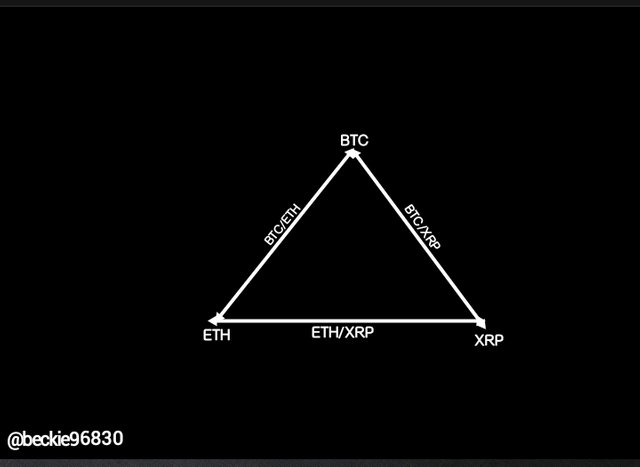
For instance, Assuming an investor has 0.05 BTC and spotted a triangular arbitrage between trading BTC, XRP, and ETH. The triangular arbitrage will follow a sequence of selling 0.05 BTC to buy XRP, which its equivalent is 2285 XRP. Now, selling the 2285 XRP to purchase ETH, which is equivalent to 0.7309715 ETH. Lastly selling the ETH to buy back BTC, the value of BTC received was 0.051 BTC which earned the investor a profit of 0.001 BTC.
Triangular Arbitrage Risk
There are some risks involved when using the triangular arbitrage strategy, they include:
1- Price Slippage
Slippage occurs when a trade order was executed at an unintended price, often because of low liquidity, high market momentum, high volume movement of price. This affects the outcome of triangular arbitrage because any order slippage will affect the anticipated profit.
2- Low liquidity
Low liquidity in exchanges can affect the pricing of assets. Triangular arbitrage requires exchange between three assets, less liquid assets are relatively more expensive as a result of spread. This can affect the pricing of these assets, thus reducing the targeted profit percentage.
3- Exchange Data
Some exchanges approximate longer decimals to the nearest significant figures, thus reducing the actual value of the asset exchanged. This can impact the outcome of a triangular arbitrage because some crypto-asset price is approximated in 2 significant figures, some in 3 significant figures and other are 4 significant figures.

Conclusion
Crypto asset diversification is a good risk exposure management strategy, that protects the investor's capital through the splitting of investments across multiple assets. This approach is used by high skilled investors to mitigate losses and Hedging investment portfolios.
Arbitrage trading offers a low-risk short-term investment, that capitalizes on the price difference between cryptocurrencies or exchange-listed prices. This trading strategy requires trading experience and speed trade executions to maintain profitability, avoiding constraints like slippages, etc.
Thank you professor @fredquantum for this educative research and practical-based lesson.
Amazing explanation from you. I really like your presentation style too.
Take care.